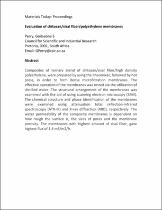JavaScript is disabled for your browser. Some features of this site may not work without it.
- ResearchSpace
- →
- Research Publications/Outputs
- →
- Journal Articles
- →
- View Item
| dc.contributor.author |
Agboola, O

|
|
| dc.contributor.author |
Fayomi, OSI

|
|
| dc.contributor.author |
Sadiku, ER

|
|
| dc.contributor.author |
Ayoola, A

|
|
| dc.contributor.author |
Mokrani, T

|
|
| dc.contributor.author |
Mbuli, BS

|
|
| dc.contributor.author |
Popoola, P

|
|
| dc.contributor.author |
Perry, Goitseona S

|
|
| dc.date.accessioned | 2021-02-16T13:12:00Z | |
| dc.date.available | 2021-02-16T13:12:00Z | |
| dc.date.issued | 2020-07 | |
| dc.identifier.citation | Agboola, O., Fayomi, O., Sadiku, E., Ayoola, A., Mokrani, T., Mbuli, B., Popoola, P. & Perry, G.S. et al. 2020. Evaluation of chitosan/sisal fiber/polyethylene membranes. <i>Materials Today: Proceedings.</i> http://hdl.handle.net/10204/11774 | en_ZA |
| dc.identifier.issn | 2214-7853 | |
| dc.identifier.uri | http://hdl.handle.net/10204/11774 | |
| dc.description.abstract | Composites of ternary blend of chitosan/sisal fiber/high density polyethylene, were prepared by using the Rheomixer, followed by hot press, in order to form dense microfiltration membranes. The effective operation of the membranes was tested via the utilization of distilled water. The structural arrangement of the membranes was examined with the aid of using scanning electron microscopy (SEM). The chemical structure and phase identification of the membranes were examined using attenuation total reflection-infrared spectroscopy (ATR-IR) and X-ray diffraction (XRD), respectively. The water permeability of the composite membranes is dependent on how rough the surface is, the sizes of pores and the membrane porosity. The membranes with highest amount of sisal fiber, gave highest flux of 1.4 m3/m2/h. | en_US |
| dc.format | Abstract | en_US |
| dc.language.iso | en | en_US |
| dc.relation.uri | https://doi.org/10.1016/j.matpr.2020.06.531 | en_US |
| dc.relation.uri | https://www.sciencedirect.com/science/article/pii/S2214785320350124 | en_US |
| dc.source | Materials Today: Proceedings | en_US |
| dc.subject | Porosity | en_US |
| dc.subject | Water permeability | en_US |
| dc.subject | Scanning electron microscopy | en_US |
| dc.subject | SEM | en_US |
| dc.subject | X-ray diffraction | en_US |
| dc.subject | XRD | en_US |
| dc.subject | Flux | en_US |
| dc.subject | Fourier-transform infrared spectroscopy | en_US |
| dc.subject | FT-IR | en_US |
| dc.title | Evaluation of chitosan/sisal fiber/polyethylene membranes | en_US |
| dc.type | Article | en_US |
| dc.description.pages | 6 | en_US |
| dc.description.note | © 2020 Elsevier Ltd. Due to copyright restrictions, the attached PDF file contains the abstract of the full-text item. For access to the full-text item, please consult the publisher's website: https://doi.org/10.1016/j.matpr.2020.06.531 | en_US |
| dc.description.cluster | Chemicals | en_US |
| dc.description.impactarea | Nanomaterials Industrial Development | en_US |
| dc.identifier.apacitation | Agboola, O., Fayomi, O., Sadiku, E., Ayoola, A., Mokrani, T., Mbuli, B., ... Perry, G. S. (2020). Evaluation of chitosan/sisal fiber/polyethylene membranes. <i>Materials Today: Proceedings</i>, http://hdl.handle.net/10204/11774 | en_ZA |
| dc.identifier.chicagocitation | Agboola, O, OSI Fayomi, ER Sadiku, A Ayoola, T Mokrani, BS Mbuli, P Popoola, and Goitseona S Perry "Evaluation of chitosan/sisal fiber/polyethylene membranes." <i>Materials Today: Proceedings</i> (2020) http://hdl.handle.net/10204/11774 | en_ZA |
| dc.identifier.vancouvercitation | Agboola O, Fayomi O, Sadiku E, Ayoola A, Mokrani T, Mbuli B, et al. Evaluation of chitosan/sisal fiber/polyethylene membranes. Materials Today: Proceedings. 2020; http://hdl.handle.net/10204/11774. | en_ZA |
| dc.identifier.ris | TY - Article AU - Agboola, O AU - Fayomi, OSI AU - Sadiku, ER AU - Ayoola, A AU - Mokrani, T AU - Mbuli, BS AU - Popoola, P AU - Perry, Goitseona S AB - Composites of ternary blend of chitosan/sisal fiber/high density polyethylene, were prepared by using the Rheomixer, followed by hot press, in order to form dense microfiltration membranes. The effective operation of the membranes was tested via the utilization of distilled water. The structural arrangement of the membranes was examined with the aid of using scanning electron microscopy (SEM). The chemical structure and phase identification of the membranes were examined using attenuation total reflection-infrared spectroscopy (ATR-IR) and X-ray diffraction (XRD), respectively. The water permeability of the composite membranes is dependent on how rough the surface is, the sizes of pores and the membrane porosity. The membranes with highest amount of sisal fiber, gave highest flux of 1.4 m3/m2/h. DA - 2020-07 DB - ResearchSpace DP - CSIR J1 - Materials Today: Proceedings KW - Porosity KW - Water permeability KW - Scanning electron microscopy KW - SEM KW - X-ray diffraction KW - XRD KW - Flux KW - Fourier-transform infrared spectroscopy KW - FT-IR LK - https://researchspace.csir.co.za PY - 2020 SM - 2214-7853 T1 - Evaluation of chitosan/sisal fiber/polyethylene membranes TI - Evaluation of chitosan/sisal fiber/polyethylene membranes UR - http://hdl.handle.net/10204/11774 ER - | en_ZA |
| dc.identifier.worklist | 23752 | en_US |






